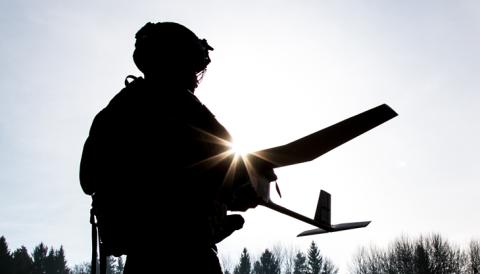[October 13, 2020]
AI for Maneuver

We recently had the opportunity to discuss AI for Maneuver with the Secretary of Defense and its role as one of the cornerstones of the DoD’s JADC2 operating concept, along with battle management networks and hypersonics. I wanted to highlight some of the aspects of this discussion from the industry perspective on what AI for Maneuver is, its relationship with JADC2, and how it can be operationalized to ensure national security and global stability in a world where technology is transforming all phases of the conflict continuum.
While doing so I will touch on DoD program management, requirements, and scaling in the DoD — all topics which could be written on at length in their own right.
What is AI for Maneuver?
A straightforward way to think of AI for Maneuver is self-driving technology for defense. There are, of course, nuanced differences (reliability requirements, “missions”, etc.) but self-driving is a good way to think about it. In a broader sense, AI for Maneuver can be thought of as “the capability of an engineered system to exhibit intelligent behavior or to perform tasks that normally require human intelligence” as described by our CTO, Carnegie Mellon University Prof. Nathan Michael.
It consists of an autonomy stack, scalable simulations coupled with reinforcement learning, software development infrastructure, robotic sensors and compute, human-machine interfaces; integration, testing, and manufacturing; training and equipping.
Why is AI for Maneuver key to JADC2?
Driverless car companies have invested hundreds of billions of dollars and recognize that it’s not viable to depend on a trillion-dollar domestic communication infrastructure for real-time decision making when it matters most, yet our JADC2 architecture builds its decision dependence on far less capable battlefield communication networks that will be relentlessly attacked, jammed, and contested. There is no path to resilient JADC2 without the ability to operate with complete autonomy, on the edge, for prolonged periods.
Sensor to shooter systems must assume disconnected intermittent and low bandwidth (DIL) comms environments, and therefore the unmanned systems that are key to these systems must be capable of executing commander’s intent in denied environments. This is what AI for Maneuver does – it enables large-scale operations in highly contested, GPS- and RF-denied environments via unmanned system maneuver, intelligent swarming, and mission execution. This is what makes it a cornerstone of JADC2.
Operationalizing AI for Maneuver
Invest in the brains. Elon Musk has noted that it is crazy to buy something that is not self-driving capable, likening it to “owning a horse.” Applying this logic to DoD, fielding and deploying new unmanned systems incapable of operation in RF-denied and GPS-denied environments will be like using formation warfare in a maneuver age – it won’t work. The DoD continues to invest in platforms, and of course new platforms are still required, but it must also invest in the brains to ensure the new platforms are “self-driving ready.” Clearly delineating AI for Maneuver in each program is one way to drive programs to invest in AI for Maneuver – this would be one path toward implementing the bi-partisan Future of Defense Task Force recent recommendation around requiring every major defense acquisition programs to evaluate at least one AI or autonomous alternative and ensuring the program “be AI-ready.”
E.g.:
Program XYZ
- XYZ Platform Development Cost: $XXXM
- XYZ AI for Maneuver (Self-Driving Technology) Development Cost: $XXXM
On Program Management
“AI is the new electricity.” – Andrew Ng, Chief AI Scientist at Baidu
The topic of program of record often comes up with strategic capabilities. A program of record centralizes the funds and management of capability. This makes sense for a number of different capabilities that are distinct and lack clear synergies – tanks, planes, submarines, etc.; but when a capability or technology is synergistic to every single platform, it is better to integrate the capability into existing programs rather than to create new ones — again, called out by the Future of Defense Task Force recent recommendation.
The DoD doesn’t have a program of record for electricity; instead, every program assumes there will be electrical components and ensures funding exists for those components. AI for Maneuver is a capability and technology that can positively impact every DoD program that touches a platform. There are some AI capabilities where centralization of program management makes sense — such as what the JAIC is doing with computer vision algorithms, but AI for Maneuver will likely fare far better when the programs themselves implement AI for Maneuver in their program plans.
On Requirements and Funding
In the DoD world, the funding that matters is tied to requirements. This has hindered the Department’s ability to quickly operationalize capabilities such as AI for Maneuver, where there are few programs that have contemplated these requirements. DoD requirements writers have difficulty capturing these requirements, and what is technologically possible is moving faster than the JCIDs process can keep pace with. This has been widely acknowledged. So how do program managers get funding for AI for Maneuver if funding is tied to requirements, and there are no requirements? This is a tough problem, and while examining potential solutions, I looked concurrently at the problem of scaling.
On Scaling in the DoD
It has never been easier for a small, new startup to win a small contract with the DoD. The Department’s efforts here should be recognized and lauded. The challenge that remains is creating a path to scale – taking promising technologies and products and going from $1M to $5M to $10M to $20M to $40M to $80M to $160M and beyond. This is an even bigger challenge when you combine this reality with the lack of requirements (and subsequent lack of funding).
Paths to scale will lead to greater private capital investment into defense technology and greater industry competition, which will yield better products and better prices, and prevent concerns such as vendor lock. One only needs to look at what bringing SpaceX into the national security realm did for pricing, products, and vendor lock.
Scaling in Defense shouldn’t require a billionaire founder with access to endless dollars in order to survive the infamous valley of death. Enabling specific organizations with the technology mindset and tech-savvy workforce, such as DIU or AFWERX, with a “scaling fund” — funds specifically designated to help bridge the valley of death between prototype, initial acquisition, and program of record for promising products, technology and capability that may fall outside traditional requirements and program management processes — would make a significant difference. There are a number of different ways that scaling funds could be used, and a number of different implementation paths, but at its heart it would be used to advance both prototyping activities and acquisition and sustainment activities. Something resembling a scaling fund was recently called out in the National Security Commission on AI report to address the DoD’s gap between prototype and program of record.
Summary
To use the Future of Defense Task Force words, in closing “The United States must undertake and win the artificial intelligence race by leading in the invention and deployment of AI.” AI for Maneuver is a critical component of the AI race, and of JADC2, and should be prioritized accordingly.









